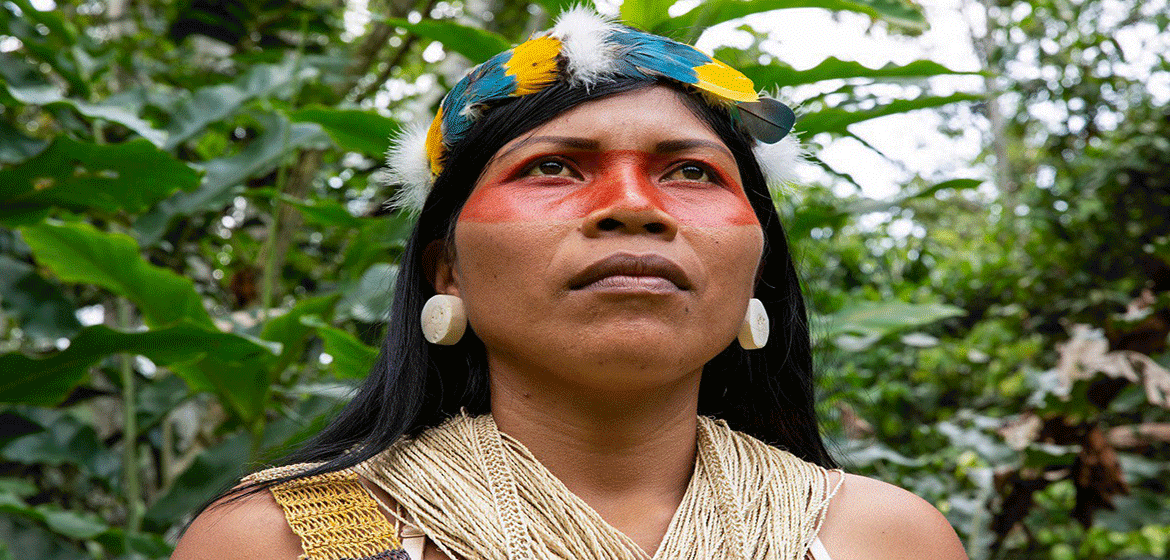One of this year’s most powerful voices in human rights is Nemonte Nenquimo, an indigenous and environmental activist from the Ecuadorian Amazon region. This International Day of Human Rights, we reflect on how Nemonte’s leadership, and the leadership of Indigenous peoples around the world, matter for the future of the planet.
Keeping forests standing, and oil in the ground.
For years, Nemonte has been fighting for Indigenous peoples’ right to a healthy environment, free from oil exploration. As president of the Coordinating Council of the Waorani Nationality of Ecuador-Pastaza, and co-founder of , Nemonte was able to overturn a court ruling in Ecuador earlier this year, preventing the government from selling land in the Amazon to oil companies on the Waorani territory. For Waorani people, the right to a healthy environment, and the ability to protect their forests, traditions and territories, depends on secure land rights and long-term agreements with companies and governments.
Nemonte was highlighted in , the and , and she received the prestigious. Alianza Ceibo, a coalition of 70 communities across the Ecuadorian Amazon, co-founded by Nemonte, recently won the UNDP-led for their efforts to protect 20,000 square kilometres of primary rainforest. During an interview with Nemonte at UNDP’s, a side event to the UN Biodiversity Summit in September 2020, she spoke of the challenges Indigenous peoples face in protecting their rights and shared her vision for a sustainable future.
Lessons from the Waorani — defenders of human and environmental rights
The Waorani people and other Indigenous nations across Ecuador are partners in a project supported by UNDP’s Small Grants Programme called.” The project brings together indigenous peoples to define a collective vision for their territory. Central to the governance model and structure of the Waorani people is communal decision-making, gender equality, and respect for the land. Matilde Mordt, Resident Representative of UNDP Ecuador, noted during the interview with Nemonte, “This community model is a call for us to rethink our development models and the changes needed for the survival of the planet and of future generations.” There is much to learn from indigenous models of governance and relationship with nature.
The future of our planet lies in indigenous hands
Indigenous lands matter for the future of our planet. Forests managed by indigenous peoples retain the carbon equivalent of approximately annual global emissions, and have than all other categories of land management, including government-managed protected areas. But indigenous territories, cultures, health, livelihoods and even lives are at risk from logging, pollution, oil extraction, and mining. Since December 2015, an average of. The biggest drivers of these conflicts are industrial agriculture, oil, gas, and mining — the same threats facing the Waorani people.
To the western world, [they think] in the jungle there are resources, nothing else. Only oil under the ground, gold, wood to deforest the territory for cattle. But for us, indigenous peoples, it is full of life, full of resources that have sustained our life for thousands of years. — Nemonte Nenquimo
Support, political will, and land rights for Indigenous peoples
Over 80 percent of states recognize the right to a healthy environment, but these commitments must be matched by strong systems of governance, transparency, and accountability. As Michele Bachelet Jeri, United Nations High Commissioner for Human Rights ; “Under human rights law, we must protect the rights of those who protect our planet. We must respect knowledge of environmental systems held by women and girls and indigenous peoples.”
We demand respect for our right to life and the rights of nature. We, as Indigenous peoples, know how to respect the forests, and we have lived together with her for thousands of years, for centuries. [Indigenous peoples] are at the forefront, but we want people from [other] societies…to respect and take up that fight as well. If we don’t respect this land, we will leave nothing for the future. — Nemonte Nenquimo

Waorani people protest for the right to a healthy environment, and the ability to protect their forests, traditions and territories, which depends on secure land rights and long-term agreements with companies and governments. Photo: UNDP Equator Initiative
Indigenous peoples who are protecting their territories and forests are securing the very air we breathe, the water we drink, and the future of our planet. But we must heed the lessons taught by Nemonte, and other indigenous peoples, by supporting their right to a healthy environment.
Source:
Related to SDG 16: Peace, justice and strong institutions and SDG 10:Reduced inequalities



